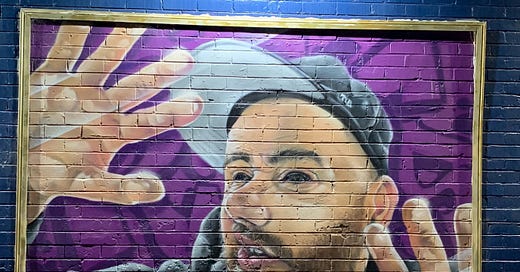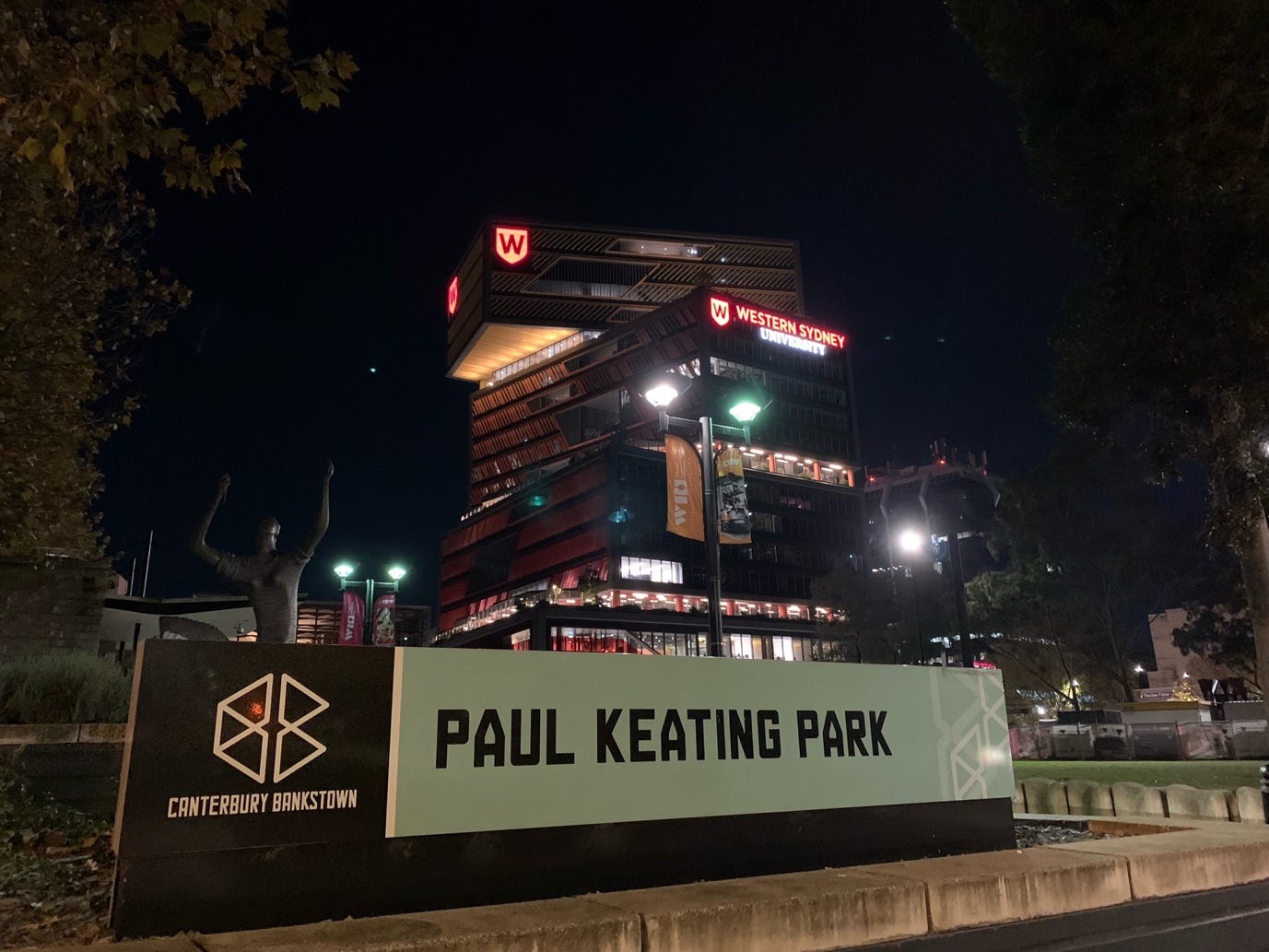Student Equity Symposium
Reflections on day one of an equity symposium, cheese toast and other matters
Theoretically, one doesn’t get much more ‘Accessible Quality’ than an Australian Student Equity Symposium. So I’m throwing together some quick thoughts on the day one program, with primary emphasis on the Minister’s address, and including some pics of the conference location.
‘Access, Achievement, Accord 2024: The Australian Student Equity Symposium’ included representatives from almost every university in the sector, peak bodies, practitioners, researchers, students, accord panellists, politicians and bureaucrats. Amongst these were friends and colleagues, and new contacts and collaborations. The event was held in peak equity territory of Western Sydney’s Bankstown.
Cheese Toast
Jason Clare is, in my opinion, one of the most effective communicators in the Australian parliament. His speech put a spotlight on the ‘beacon’ that is the new Western Sydney University Bankstown Campus (pardon the pun). The campus is just across the road from his office and he spoke with pride about his part in the opening of this campus some 12 months earlier.
As a self-avowed flaneur I can attest to the prominence of the Bankstown Campus. Surrounding streets comprise a commercial precinct consistent with one of the most diverse communities in Australia. Low-rise high street type shops, three quarters of which (at least on a Monday night) were shuttered. The socioeconomic status of the area can be inferred from the types of shops that are present, and it is fair to say that these types of pawn shops are not high-brow. The restaurants that were open filled the atmosphere with aromas of Vietnamese, Cambodian, and Lebanese cuisine. I’d have much preferred to have eaten at one of these places than the Sports Club Pokie Palace that the conference dinner was held.
By Tuesday morning the grocers, butchers and cafes were open and the hub of Bankstown central train station and bus depot was a hive of activity. Sight corridors in the vicinity can’t help but draw attention to the 19-story building and prominent university branded signage. The architects did a great job of capitalising on constructing a building of significance, the symbolic relevance is multi-faceted. Not only a beacon in architecture, but situated adjacent to Paul Keating Park, and a tangible manifestation of our former Prime Minister’s legacy.
The Minister’s speech reiterated points made in other speeches, and was delivered with authority and conviction. His narrative style regularly includes touch points of:
his personal origin story;
statistics evidencing educational inequality;
a case study of a hero’s journey and transformation power of higher education;
policy objectives, and
examples of policy in detail.
The Minister also demonstrated impressive command of his brief by taking questions from the floor on a range of equity in education related matters. To me, what was most impressive was the way in which he free-styled the intro, playing to the room and acknowledging connections with prominent members of the audience. He did all this whilst ensuring commitments to equity and his own background were made clear.
To illustrate, when acknowledging that Barney Glover was back to his old stomping ground as ex-VC of WSU and now Commissioner of Jobs and Skills Australia, the Minister referenced a shared experience that cemented his equity credentials and engaged the audience.
A return to the Ministers earlier workplace, Sizzler, was perhaps not quite like Barney’s, but got a laugh from the audience. As a fellow alumni of Sizzler myself, I can appreciate where the Minister might have acquired his Rizz, and can assume we share a love for, and mourn the disappearance of Sizzlers legendary cheese toast.
In terms of the takeaways from his speech and Q+A with the conference, the point he reinforced repeatedly was that the Accord cannot be delivered in a single budget, or a single parliamentary term. The interdependencies between early childhood and school education will not be resolved by universities in the short term.
Progress towards Accord objectives will require stewardship that will outlast a minister of Education or government. Hence the need for and importance of the Australian Tertiary Education Commission.
My personal view is that, notwithstanding his passion for equity and education, that he’ll take on a more prominent political role in the medium term. The Government may well see it necessary to redeploy his political and communication skills to other portfolios before too long.
Informal chats with colleagues in the evening went so far as to interpret the speech as signalling a farewell. His work in establishing a new policy architecture is done, and perhaps time to hand over to an uber administrator to implement the reforms.
Other thoughts
The Center formally known as Prince
The Australian Centre for Student Equity and Success marks a pivot from the National Centre for Student Equity in Higher Education. The event was not only an opportunity think about the Accord in a post-budget context, but to communicate and socialise a new approach to sector leadership of student equity.
It was the first time I’d seen Centre Director Shamit Saggar in action and now have a clearer picture of how ACSES fits into the policy context and the strategic direction that Shamit is leading. His erudite intro remarks emphasised the importance of evidence in policy making, accentuated by keynotes by Omar Khan (CEO of TASO – Transforming Access for Student Outcomes in Higher Education), and Barney Glover (Commissioner of Jobs and Skills Australia). This is an important government supported pivot and hope ACSES can pull it off.
Ian Li’s magic rope trick routine would suggest that not only does the Centre have strong quantitative and economic analytical capabilities and leadership, but can do so with some engaging showmanship.
In terms of optimising the pivot, so much of what is done in student equity in higher education is not subject to robust evaluation. SEHEEF provides a nascent framework, but is yet to be fully operationalised. There are risks in my view that we commit excessive evaluation capacity on equity, whilst leaving base funding more or less out of scope for any more robust form of evaluation. The balance needs to be right.
The Road To Reform
Members of the Accord Panel, and implementation group shared their views on the policy review process. I’ve mentioned before that I thought the Accord ran a good process, and this was again affirmed by several speakers.
To me we are at the cusp of a transition point from how we got here - Panel members socialising recommendations and process - to how are we getting on with it - technical and fiscal challenges of implementation.
The vibe in the room was very much one of optimism that the Accord can be delivered. That the unresolved questions are not unresolvable. That the road map laid out by the Accord will be progressively implemented.
Peak Body Targets
Representatives from each of the peak bodies discussed target setting processes. Whilst a canny move to bring them all to the stage at the same time, my sense is that each individually and collectively would benefit the sector if they were more attuned to how their members institutional capacity around teaching, research, and quality could be deployed to Accord objectives.
Keynote TASO
Omar Khan was another canny invite to be part of proceedings. The UK is well ahead of Australia in terms of policy evaluation, and it was interesting to see examples of how they go about evaluating access and success related interventions.
Throughout the day there were reminders that we have much to learn in Australia from other jurisdictions. The UK, USA, NZ, South Africa and others all came up in panel discussions or 1:1 conversations.
Disability
Worth putting in quotes the Minister’s remarks on disability. There is a window here to get beyond misrecognition of disability, and I hope we can do better.
I have also heard concerns from the disability community that the Accord didn’t get everything right on disability.
I hear you.
We need to get it right in the implementation and we will work with you to do that.
Thanks for reading.









Thanks Matt - looking forward to hearing about Day 2 (fingers-crossed) - I managed to view the student panel online - it was excellent